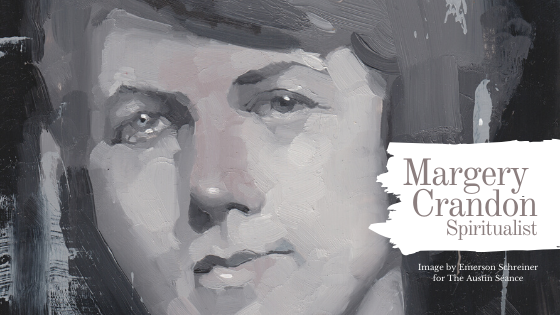by Jake Cordero
For The Austin Séance
Mysterious rapping, eerie music, otherworldly voices — witnesses ascribed these strange phenomena and others to the historic séances of Margery “Mina” Crandon, one of America’s most celebrated spiritualist mediums.

A controversial Jazz Age figure, Crandon stumped investigators for decades — including those with Scientific American magazine. Others, however, suspected fraud. Some activities associated with the Crandon séance room appear to have rational explanations. Some do not.
In commemoration of the spiritualist medium’s birthday next month, The Austin Séance presents this quick synopsis of her storied life. We also have commissioned a new portrait of Mina Crandon, created by the artist Emerson Schreiner. The head-and-shoulder image, painted in a contemporary impressionistic style, employs dark grays and blacks. That’s a reproduction of the image at right. We also have canvas prints available on the merch page.
Early LIfe
Born Mina Stinson on July 29, 1889, the storied medium spent her youth in Ontario, Canada but eventually made her way to Boston, Massachusetts. There, she settled in one of the city’s tonier neighborhoods with her second husband, the Harvard surgeon Le Roi Goddard Crandon. Mina soon began conducting séances for friends at their home and early on purportedly made contact with her deceased brother Walter, who had been killed some years earlier in a railway accident.
 Ms. Crandon employed a “spirit cabinet” during her sessions similar to one used by The Austin Séance. A large armoire, the cabinet was constructed of wood and with a door or doors in front. The disembodied spirit of her brother Walter supposedly emerged from the cabinet, or she herself was placed within it.
Ms. Crandon employed a “spirit cabinet” during her sessions similar to one used by The Austin Séance. A large armoire, the cabinet was constructed of wood and with a door or doors in front. The disembodied spirit of her brother Walter supposedly emerged from the cabinet, or she herself was placed within it.
Witnesses to Mina Crandon’s séances reported rapping noises, mysterious music and even direct voice contact from Walter. Others reported clocks stopping and furniture moving on their own accord.
In late 1923 Mina travelled to Europe, appearing in both Paris and London. Several Parisian experts reported strange phenomenon during her séances, even though they were conducted under strict controls. In London, during a séance before the Society for Psychical Research, the group’s famous “fraud-proof” table twice rose to a height of six inches, according to reports.
The following year Scientific American assigned a committee to investigate Crandon. Committee members spent months at the task, participating in multiple sittings and taking copious notes. But they deadlocked as to the primary question before them: was Margery Crandon a fraud? In the magazine’s November 1924 edition individual committee members pronounced their own verdicts with some convinced by Margery, others remaining non-committal and only one proclaiming her a fake.
HOUDINI CRIES FOUL
That outlier who accused Ms. Crandon of chicanery was the magician Harry Houdini. The magician had taken special interest in the case of Mina Crandon, and for the specific purpose of exposing her he had constructed a special wooden box for use in the séance room. Ms. Crandon gamely agreed to conduct a séance while constrained within it. But the demonstration proved inconclusive and both Houdini and the Crandons then accused each other of acting in bad faith. Houdini (who then was adding to his fame by confronting mediums, nearly all of them women) insisted he was in the right but could only speculate as to Margery Crandon’s methods. Eventually, Scientific American wrapped up its investigation, with several of the committee members suspecting deceit on Ms. Crandon’s part, although never with conclusive evidence.

As Ms. Crandon’s sittings continued, so did the use of increasingly outlandish devices to test her abilities. Besides Houdini’s box, a second similar device also was employed, for some of her sittings — but this one constructed with glass, like a telephone booth. Another device, a “voice-cut-out machine,” provided evidence that the strange voice Ms. Crandon attributed to her dead brother could not have emanated from the medium or other sitters. But even with these restraints, the manifestations often persisted.
Unfortunately for Ms. Crandon, however, one of the more spectacular manifestations during this period ended up providing ammunition for her detractors. Séance investigators had obtained a series of thumb prints, imbedded in wax, that purportedly corresponded to prints found on a razor owned by Ms. Crandon’s dead brother. But the investigators later cited evidence that the prints were not those of the brother, but rather of an early participant in one of her séances.
And then even more damning was an accusation supposedly made by Malcom Bird, a psychic investigator and frequent séance participant. In 1930, after a falling out with the Crandons, he reportedly was preparing to claim the medium had asked him to participate in fraudulent activity. But he resigned from the American Society for Psychical Research shortly after his supposed accusation came to light and little was ever heard from him again.
Were the skeptics correct? Or did Margery “Mina” Crandon actually possess some real paranormal ability? Keep in mind that the Crandons had little financial interest in fraud — they lived well and in a fine home — and had very much to lose by it. Her husband was a respected Harvard surgeon and professor, and he staked his estimable professional reputation on his wife’s abilities. If the Crandons were frauds, they were not of the two-bit carny variety.
Also know that while some phenomena can be explained through alternative means, others remain a mystery. For instance, during a 1924 séance the spirit of Mina’s dead brother supposedly again made his presence known and reportedly cursed Houdini, predicting the magician’s life would end prematurely. The great magician died less than two years later, on Halloween night, 1926.
Mina Crandon herself died on November 1, 1941, almost precisely 15 years afterwards.
